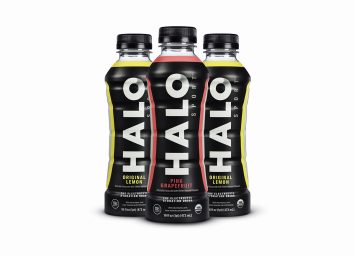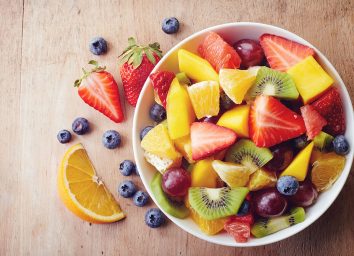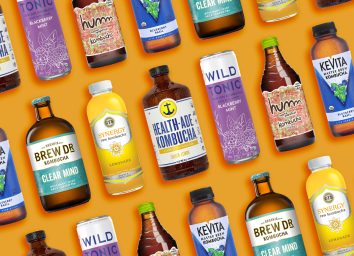Every Popular Added Sweetener—Ranked!
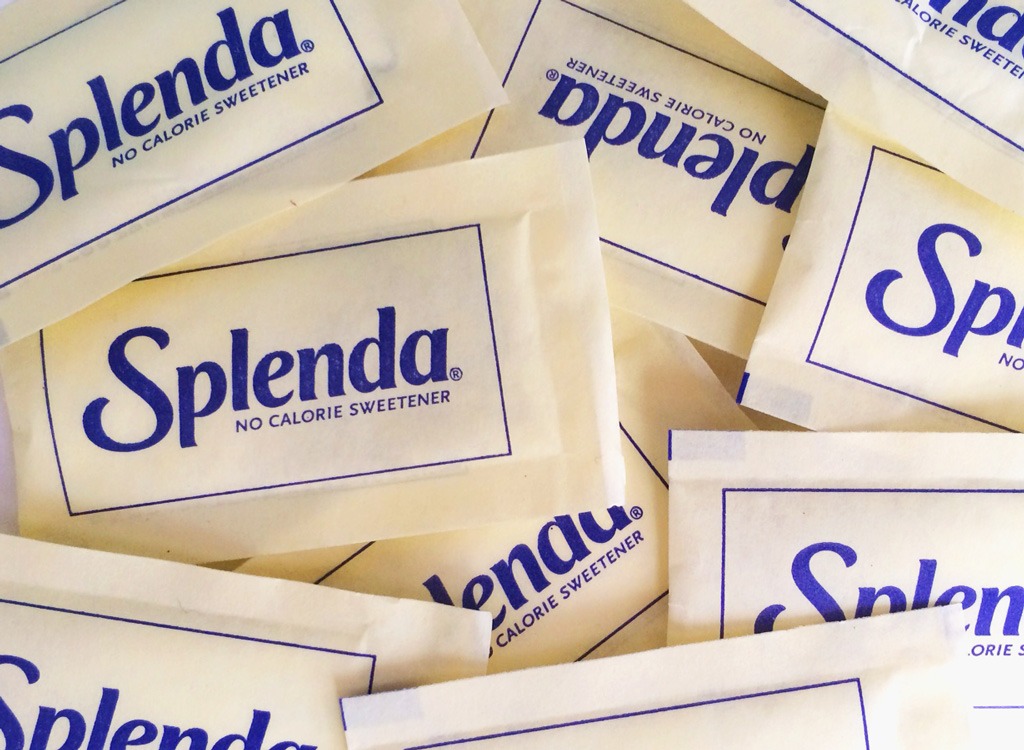
Out of all the possible factors for the increasing prevalence of metabolic diseases like obesity and type 2 diabetes, added sugar—of which we consume an average of 32 teaspoons a day—and processed foods have the biggest, brightest targets on their backs. Thanks to a desperately-needed rise in public awareness of the issue, the resulting outcries from Americans have forced the food industry to take action. (And because, in a Dietary-Guidelines first, the U.S. Department of Health and Human Services made a recommendation that Americans consume no more than 10 percent of daily calories from added sugars.) As a result, food manufacturers are desperately scrambling to come up with replacements.
On one side, you have the anti-carb, anti-calorie, and anti-sugar movement. Their main issue is that when we consume too much sugar, it causes our blood sugar to spike and crash (which makes us crave more food—more quickly), our bodies to build up an insulin resistance (by which we can no longer properly metabolize sugar, storing it as fat instead), and ultimately causes us to rapidly gain weight. Their solution is to replace sugars with artificial sweeteners and sugar alcohols. Because these sweeteners stimulate your sweet-taste signals without being broken down by your body, they allow products to maintain an appealing taste without calorically widening your waist or adding to your health issues. (So they think…)
On the other side, you have the plant-based, all-natural movement. Their main issue is that food is way too processed and artificial. It’s because added sugars are refined into their simplest form that we gain weight so easily; when these added sugars are extracted from their sources (for example, fructose from fruit), they lack both their fiber, which helps slow digestion, preventing blood-glucose spikes, insulin spikes and liver damage, as well as their beneficial antioxidants, essential vitamins, and minerals—truly making them “empty calories.” So if you’re going to sweeten your food, you should use products in their natural forms or those that are naturally produced, so they retain their appealing nutrients. But just because these sweeteners are natural doesn’t mean they’re health foods.
Both are right when it comes to the evils of added sweeteners, but whose solution is better? Keep reading to find out.
How We Ranked Them
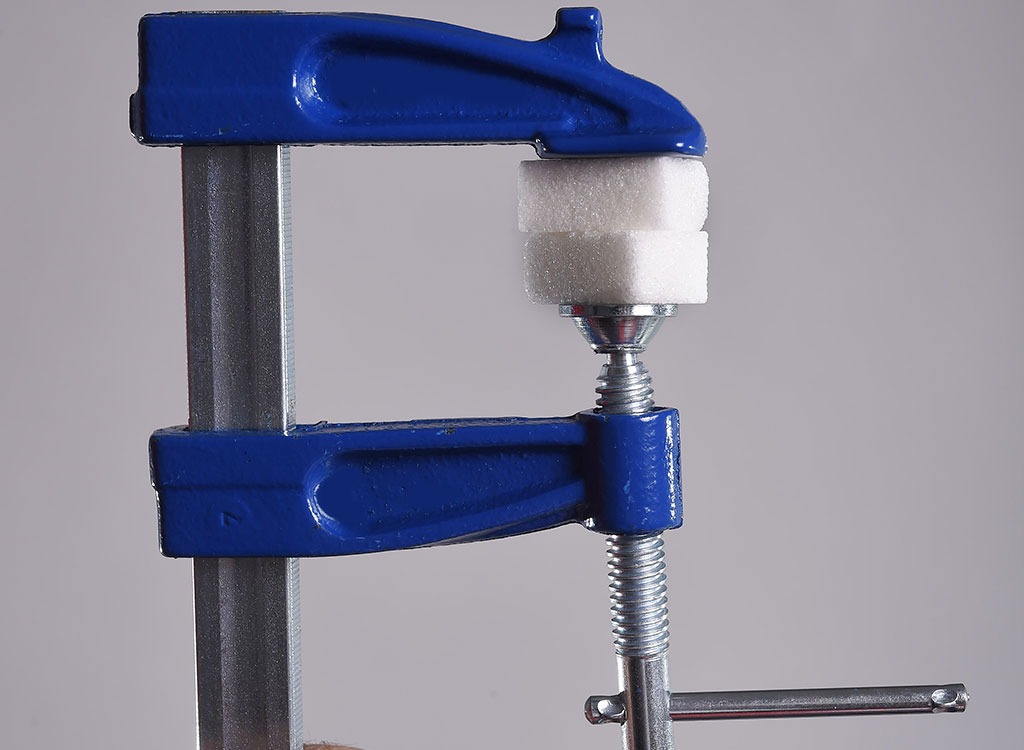
We combed through studies, examined nutritive profiles, and consulted nutritionist Isabel Smith, MS, RD, CDN, to determine our ranking factors. It turns out, it’s not just empty calories we need to be worried about. Here were our guidelines:
Fructose
Experts have speculated that Americans’ increased intake of fructose—which our body turns into fat and inflammatory compounds more easily than it does with glucose—is to blame for the equivalent increase in rates of metabolic disorders. And that’s regardless of if it’s bound in cane sugar or free in high-fructose corn syrup. Countless studies in humans have shown that high doses of fructose can result in insulin resistance, high cholesterol and triglycerides, belly fat accumulation, and elevated blood pressure—in as little as 10 weeks—because our liver is the only place where our body can metabolize fructose. For this reason, sweeteners were docked for higher percentages of fructose.
Glycemic Index
The glycemic index (GI) is a measure of the extent to which a food elevates your blood glucose and insulin levels. High glycemic sweeteners spike these levels, flooding your body with more sugar than it can use, which in turn, stimulates fat storage. Consuming high-glycemic sweeteners too often can result in the deterioration of our body’s regulatory mechanism, which studies suggest leads to a greater risk of insulin resistance, cardiovascular disease, type 2 diabetes, and inflammatory oxidative stress. While some points were deducted when a sweeter had a high GI, Smith explains that if you consumed the sugar with an item that has fat, protein, or fiber it would easily lower the GI response in your body, so we put less weight on this measurement.
Other Factors
Sweeteners that had a higher sweetness intensity were awarded some points as they would be needed in a lower volume to reach the same desired sweetness, which Smith says is a huge plus. This was also the case if a sweetener had additional health benefits such as micronutrients and antioxidants, as well as if a sweetener was less refined. On the other hand, any sugar that contributed negatively in terms of digestion, gut health, or possible contribution to cancer had points deducted.
First… The Best

These sweeteners have moderate levels of fructose, only moderately affect your glycemic index, and some even provide minerals and antioxidants—but that doesn’t mean you should be reaching for sweeteners to get those nutrients. Just think of it as a plus. And remember, even if a sweetener is listed as a “best,” it does not mean you can eat more of it. It only means that if you’re going to use a sweetener, we recommend you use this one. Consuming too much added sugar—as well as refined carbs—can increase your risk of obesity, type 2 diabetes, high blood pressure, stroke, heart disease, and even cancer. So regardless of any potential health benefits, be sure to use all of these sweeteners in moderation.
Sorbitol

Type of sugar: Sugar Alcohol
Glycemic Index: 4
Smith tells us that sugar alcohols can have a major negative impact on things like gas and bloat because they’re only partially digested before they move through your digestive tract. However, they do have the added benefit of not aiding in tooth decay like sugar. Sorbitol is a naturally-occurring sugar alcohol which is found in many stone fruit and some berries. It isn’t zero calorie like other sugar alcohols (around 60 percent that of sugar) but because it has a low digestive tolerance and lacks sweetness, you’ll end up needing more of it to achieve your desired sweetness, meaning you’re at a greater risk of the alcohol’s laxative side effects.
Xylitol
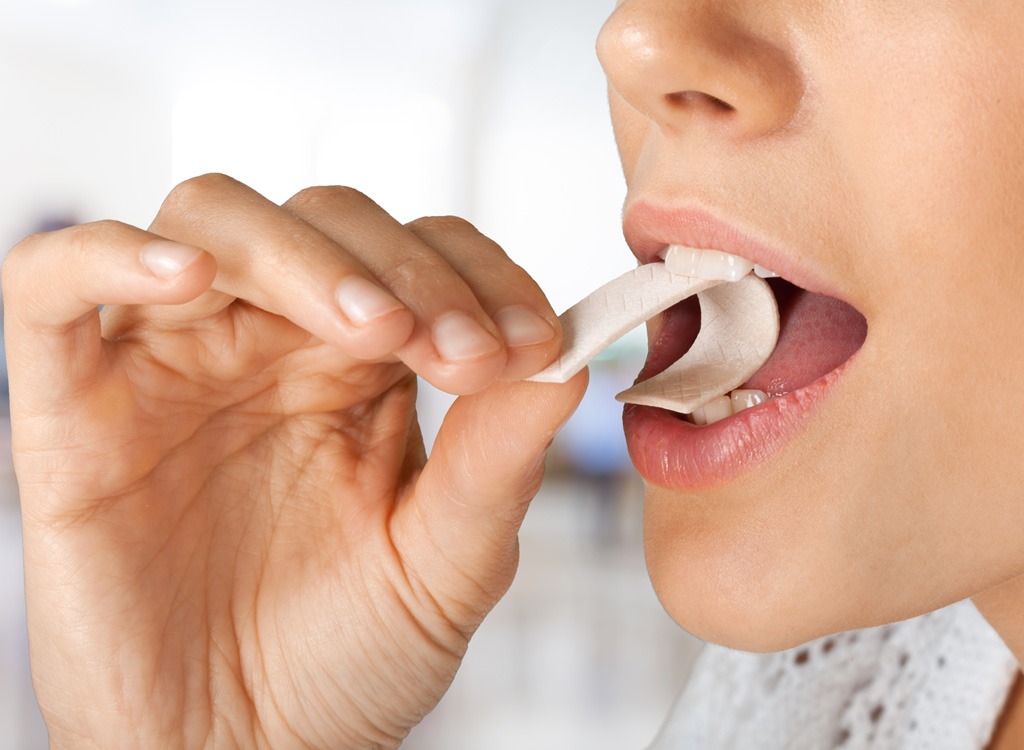
Type of sugar: Sugar Alcohol
Glycemic Index: 12
Xylitol is a sugar alcohol you can find in chewing gums that occurs naturally in strawberries, mushrooms and other fruits and vegetables, most commonly extracted from the pulp of a birch tree. Unlike real sugar, sugar alcohols don’t encourage cavity-causing bacteria. Many studies have found that xylitol can actually reduce the risk of cavities and dental decay that’s associated with high intakes of sugar, and other studies show that it may improve bone density, suggesting it can play a role in preventing osteoporosis. Unfortunately, as with many sugar alcohols, it has a low digestive tolerance, and may cause laxative-like side effects in high doses.
Erythritol
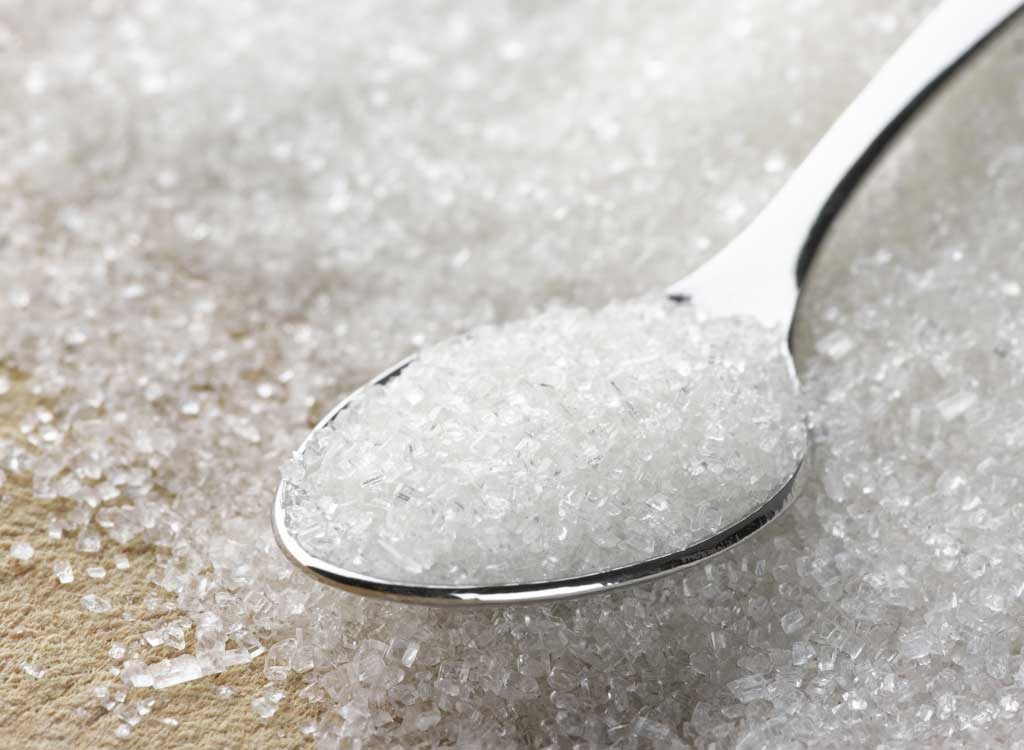
Type of sugar: Sugar Alcohol
Glycemic Index: 0
The benefit of erythritol is that it doesn’t cause the same digestive problems as other sugar alcohols. Because it’s found naturally in many foods that humans have consumed for millennia—grapes, pears, melons, and even mushrooms—our digestive system is familiar with it. It’s a popular, low-calorie polyol found naturally in foods that have been consumed by humans for thousands of years. Huge points for having no effect on our blood glucose levels and providing no belly-fat-inducing fructose. What’s more, erythritol is an antioxidant polyol so it helps reduce oxidative stress in the body by scavenging free radicals.
Luo Han Guo (Monk Fruit Extract
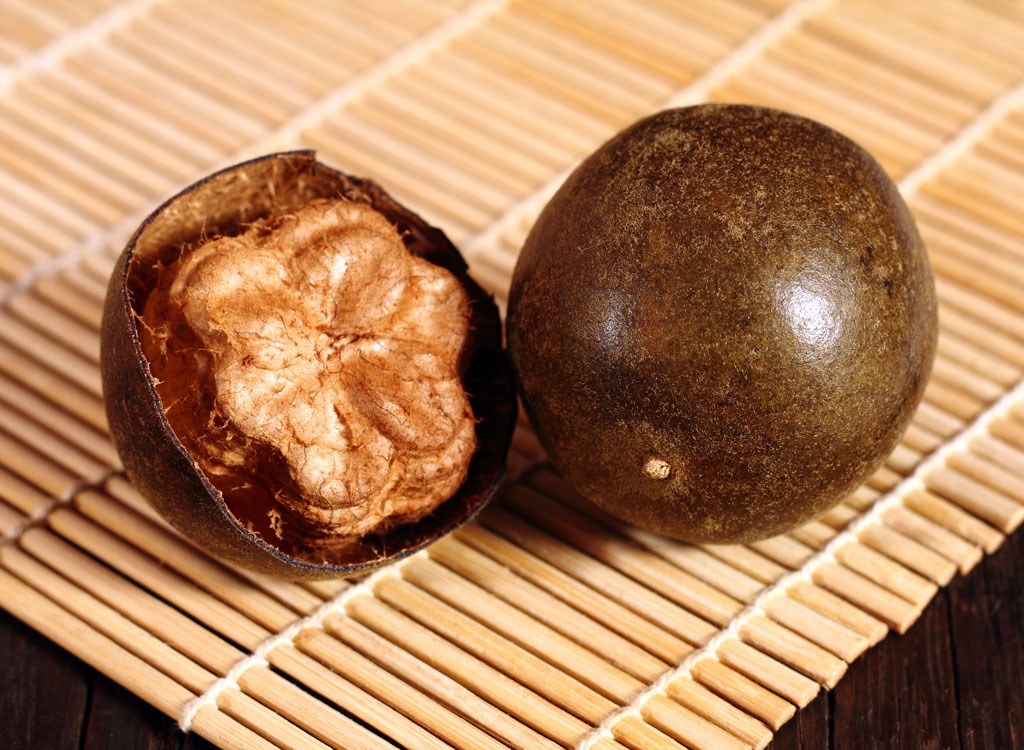
Type of sugar: Natural Sugar
Glycemic Index: 0
Even though Smith recommends avoiding zero calorie sweeteners, she gives the go-ahead to the natural sweeteners stevia and monk fruit. Luo Han Guo is also called monk fruit because of its historic cultivation by monks in China. It has been consumed for several hundred years, having been used as a sweetener and a traditional herbal remedy; however, it has not been well tested through research. This high-potency sweetener is about 200 times sweeter than sugar, so you’ll use less of it when adding it to food. This fruit is also full of antioxidants in vitamins, making it a better choice if you’re going with zero-calorie sweeteners.
Stevia
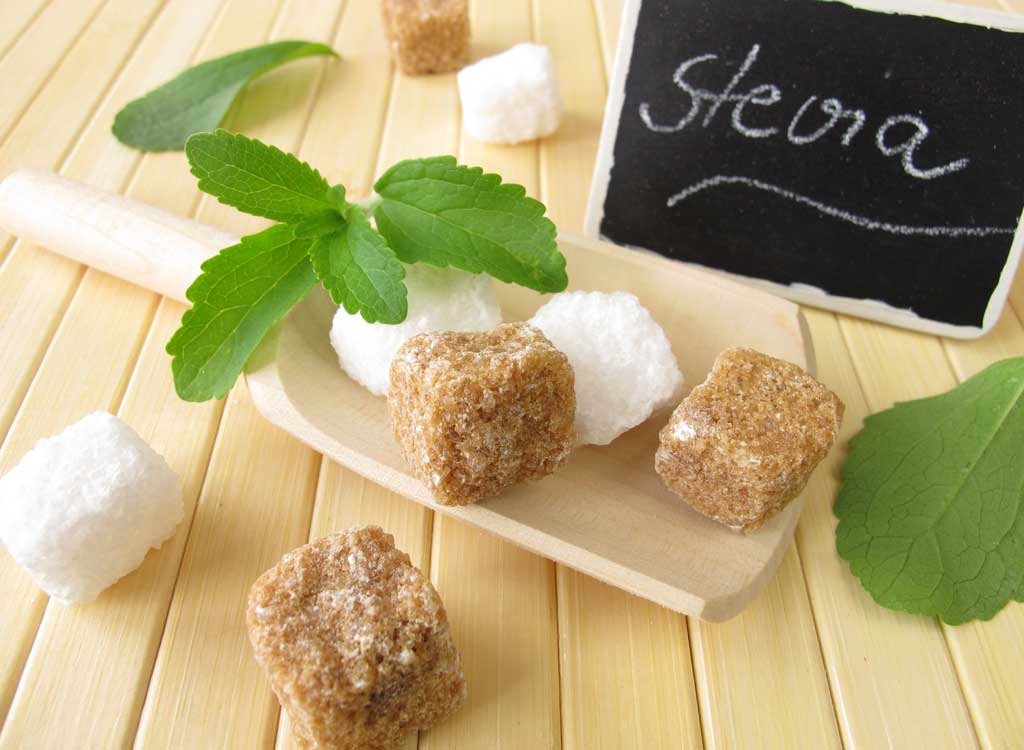
Type of sugar: Natural Sugar
Glycemic Index: 0
Stevia is derived from a plant native to South America. It’s been shown to help lower blood pressure and level-off blood sugar—making it a great way to flavor boost your coffee. Many experts have speculated that because artificial sweeteners don’t activate the release of satiety hormones, they may lead people to overeat at their next meal. However, a study in the journal Appetite found that might not be true. The research showed that whether you were healthy and lean or obese, drinking a cup of tea sweetened with regular old sugar caused participants to eat over 300 calories more throughout the day than those who consumed stevia. What’s more, stevia actually helped minimize spikes in blood glucose and insulin levels after the meal. Watch out for how much you’re using, the acceptable daily intake established by the FDA is no more than 9 packets.
Palm Sugar
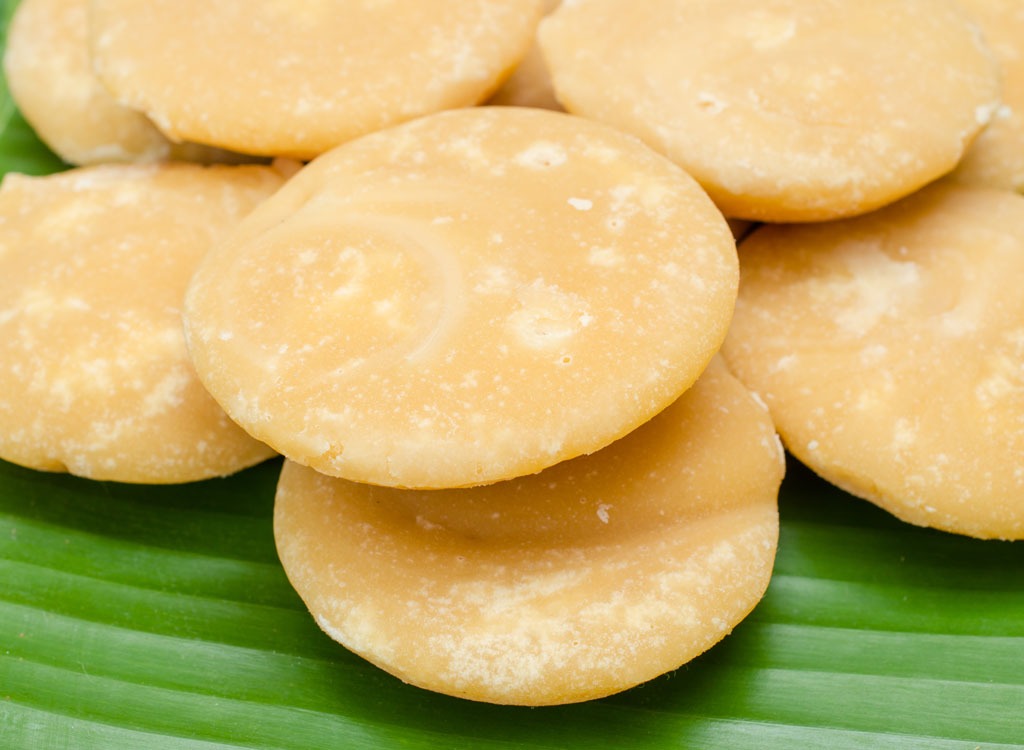
Type of sugar: Natural Sugar
Glycemic Index: 35
Many confuse this sweetener for coconut sugar, but it’s really quite different. This sweetener is made from tapping the trunk of a sugar date palm tree (the same tree that dates come from, not coconuts), similarly to how maple syrup is made. However, once this sap is collected, it’s boiled down to a syrup and then the water is evaporated out to create sugar crystals. Palm sugar is typically used in Thai or Indian cuisines. This sugar has trace amounts of phosphorous, iron, and vitamins C and B.
Coconut Sugar
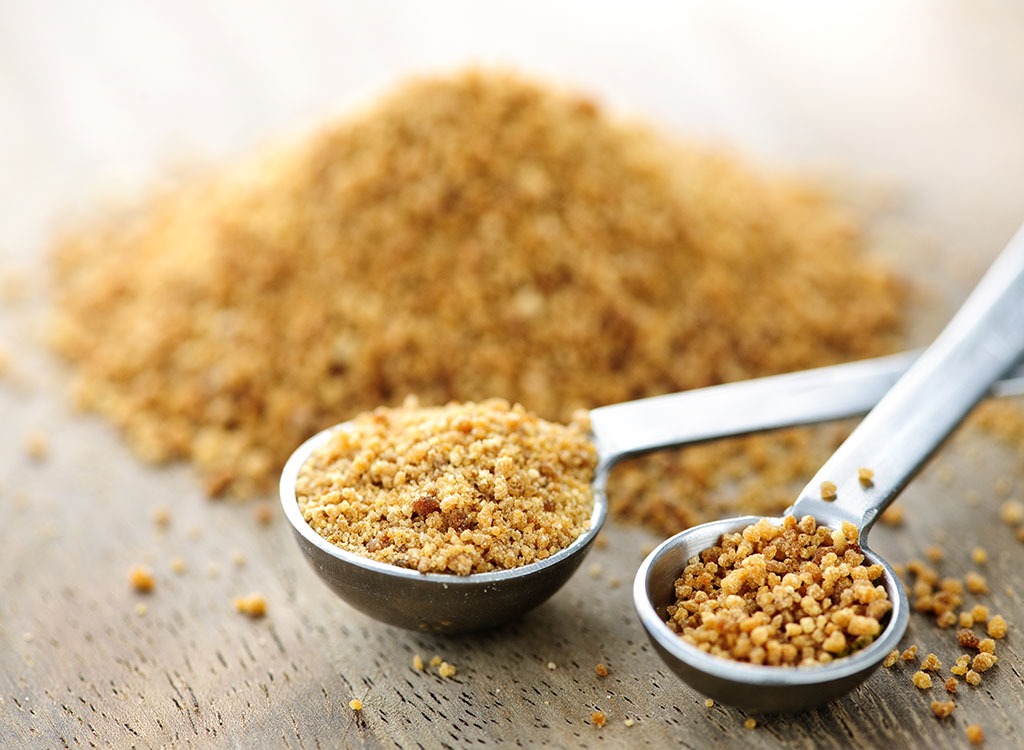
Type of sugar: Natural Sugar
Glycemic Index: 35
If you didn’t already know, we’re big fans of all things coconut here at ETNT. Coconut sugar (also known as coconut palm sugar) is derived from the nectar of coconut tree blossoms—which, unfortunately, means the blossoms can no longer produce coconuts once it’s harvested. The manufacturing process is quite natural, allowing the water to evaporate from the sap at a low temperature so the leftover sugars crystallize. (Without this evaporation process, you would be left with coconut palm syrup or nectar.) It tastes similar to brown sugar, which is why many use it as an alternative in baked goods. Coconut Palm Sugar contains mainly sucrose (75-80%). It scores well on the glycemic index list, at 35, which researchers believe is due to the small amount of soluble fiber (inulin) present. Compared to other nutritive sweeteners, coconut sugar is highest in potassium, nitrogen, phosphorus, magnesium, sulfur, and even provides some Vitamin C.
Blackstrap Molasses
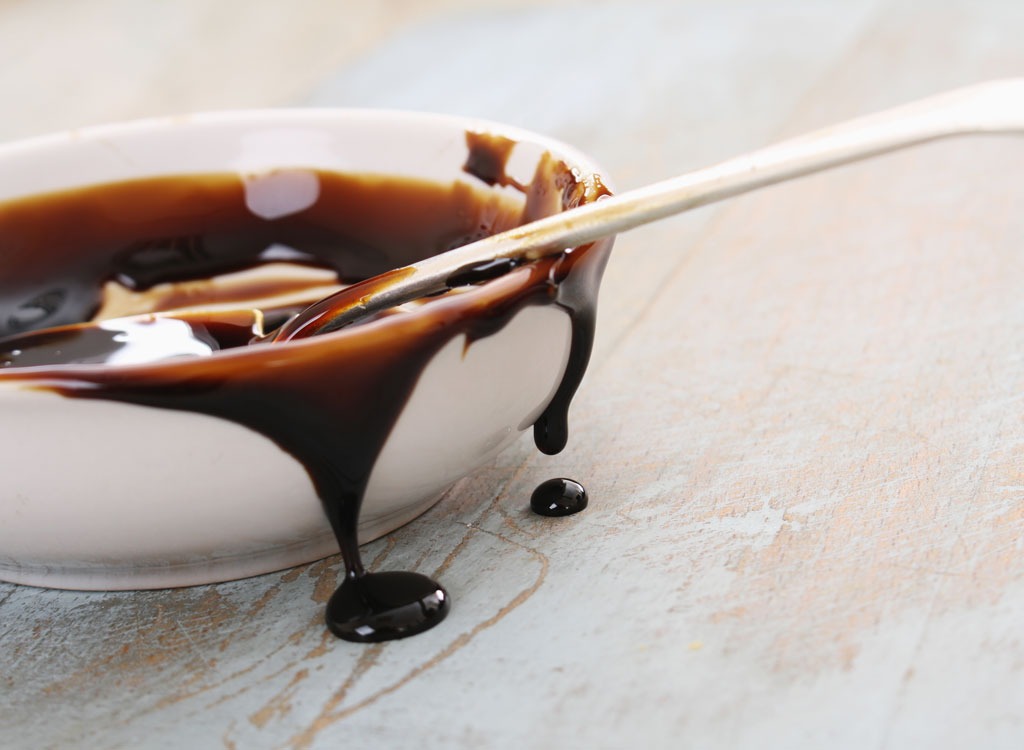
Type of sugar: Sugar Extract
Glycemic Index: 55
When sugar is made, it is boiled down to a syrup, at which point the sugar crystals are separated from their liquid. That liquid is molasses, and blackstrap molasses occur when the sugar is boiled for the third time. At this stage, the majority of sucrose from the original juice is removed; however, some basal levels still remain. Blackstrap is considered the healthiest of all molasses because it retains the most vitamins and minerals. It contains significant amounts of vitamin B6 and minerals, including calcium, magnesium, iron, and manganese. In fact, just a single tablespoon provides up to 20% of the recommended daily value of each of those nutrients. But because this syrup is more bitter than “regular” molasses, save it for use in more savory dishes like pulled pork carnitas.
Honey
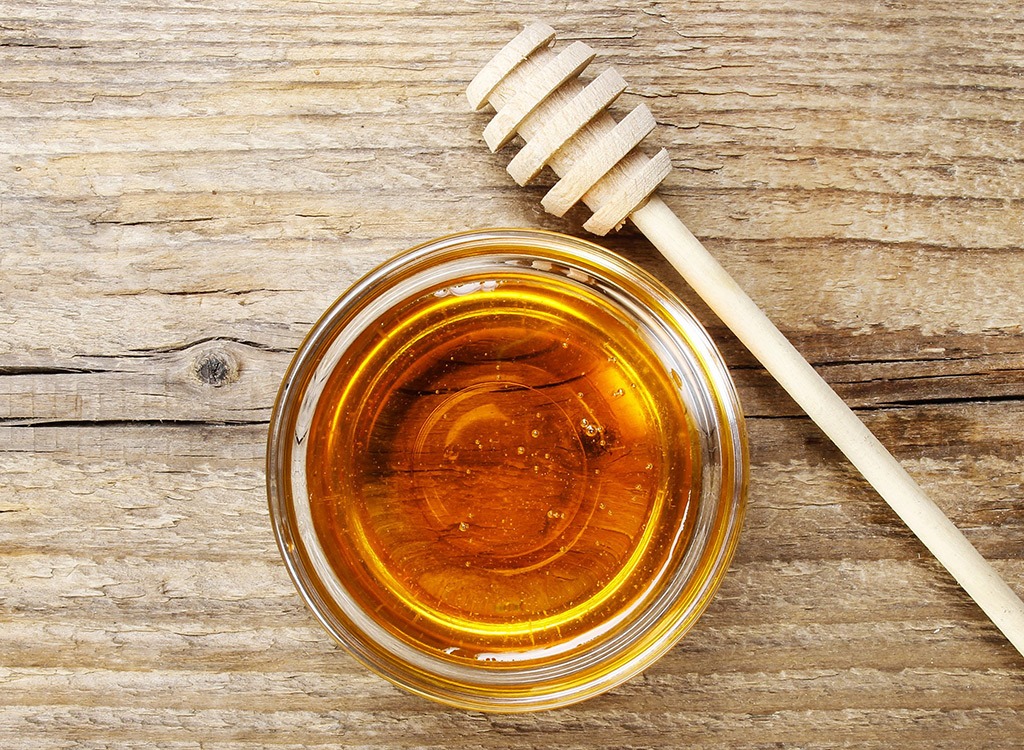
Type of sugar: Natural Sugar
Glycemic Index: 50
Honey is a combination of 5 different sugars, but it’s primarily fructose (50 percent) and glucose (44 percent). Because the fructose is “free” and there’s more of it, gram for gram honey tastes sweeter than sugar, so you end up using less of it. It contains trace amounts of proteins, vitamins, minerals, and antioxidants, of which many are beneficial polyphenols, flavonoids, carotenoids. What might be even better is that a paper in the International Journal of Biological Science suggested that honey’s moderate levels of fructose are beneficial in slowing down the rate of digestion, which ultimately contribute to its glucose-lowering effect and its possible role as an antidiabetic agent. Not to mention, its antioxidants can both lessen harmful oxidative stress in the pancreas, kidney, and liver as well as act as prevent the growth of pathogens that cause ulcers, and its high levels of oligofructose can increase levels of the beneficial gut bacteria, bifidobacteria, of which low levels have been tied to obesity. Use it to sweeten up the Very Berry Yogurt Bowl in our 5-ingredient healthy breakfasts!
Maple Syrup
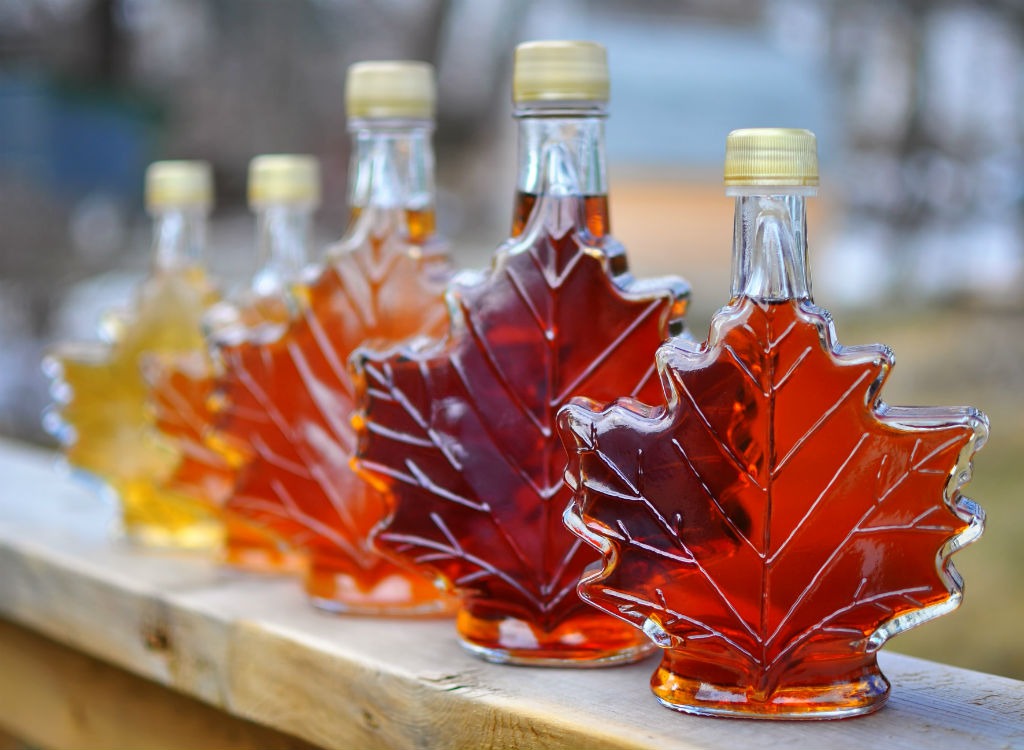
Type of sugar: Natural Sugar
Glycemic Index: 54
Pure, Grade-A maple syrup is one of the best natural sugars out there. It’s got a relatively low glycemic index, and it’s low in compounds that cause digestive problems in some people. Maple syrup is mostly made up of sucrose, but it also provides trace amounts of muscle-repairing manganese, muscle-building magnesium, fat-melting zinc, anti-inflammatory compounds, and antioxidant compounds called phenolics. But don’t go guzzling down on this Canadian staple anytime soon. Studies have only stayed on a cellular level, and researchers have yet to test the power of these antioxidants in animals or humans.
And Now for the #1 Best Added Sweetner…
Medjool Dates

Type of sugar: Natural Sugar
Glycemic Index: 42
Dates are the fruit of the date palm tree (which also provides us with palm sugar). Just under 90 percent of the carbs in dates are from sugar, which is split nearly 50/50 between glucose and fructose. Luckily, the final 10 percent of carbs are mostly fiber, which should help stabilize blood glucose levels. A study in the Emirates Journal of Food and Agriculture found that adding dates can significantly increase the total phenols and vitamin C content of your food. They also contain muscle-relaxing potassium and copper, a mineral essential to scavenging free radicals from your body, along with iron and B vitamins. To use dates as a sweetener, soak them for 10 minutes to soften the skin. Remove the pit and then blend in a food processor to make a paste.
And Now… The Worst

Anything connected with causing any form of cancer went to the bottom of the list. And according to Smith, artificial, zero-calorie sweeteners deserve a place on this list because researchers in a British Journal of Nutrition study determined they don’t affect satiety hormones—which may leave you feeling unsatisfied and looking for real food to actually fill you up. She recommends you choose a real sweetener that actually affects your satiety. All of these sugars are processed, refined, and far removed from their original sources (or completely synthesized in a lab).
Sucralose
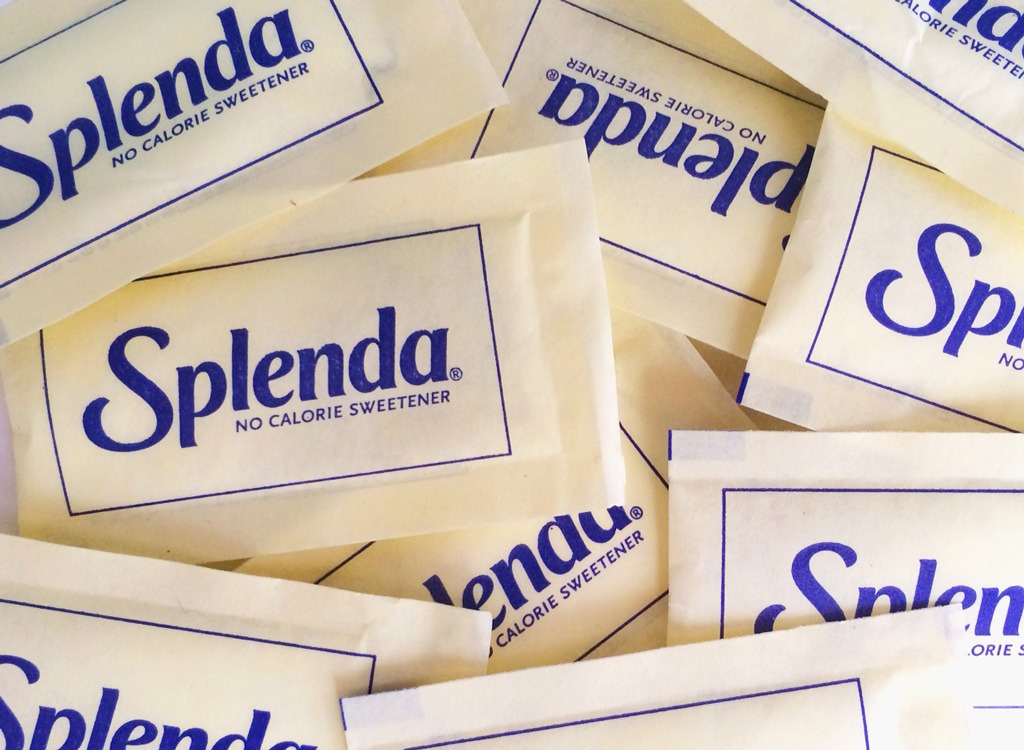
Type of sugar: Artificial, High-Intensity Sweetener
Glycemic Index: 0
You probably know it as splenda, the sweetener that’s “made from sugar, so it tastes like sugar”—but the final product is worlds different. The processing tweaks a sucrose molecule just enough so that its shape still activates your sweetness-sensors, but your body can no longer break it down, making it “zero calorie.” It also doesn’t alert your body that you’re consuming a food; however, this shouldn’t be a problem when used to sweeten nutrient dense foods (which can provide your body with satiety signals), but it will be if you’re consuming a soft drink made up of potentially harmful additives.
And even though the Center for Science in the Public Interest just downgraded sucralose from “caution” to “avoid” because a newly published study from the Ramazzini Institute found that the chemical caused leukemia and related blood cancers in male mice, CSPI president Michael F. Jacobson noted, “That said, the risk posed by overconsumption of sugar and high-fructose corn syrup, […] of diabetes, heart disease, and obesity, far outweighs the cancer risk posed by sucralose and most other artificial sweeteners.”
Raw Organic Cane Sugar
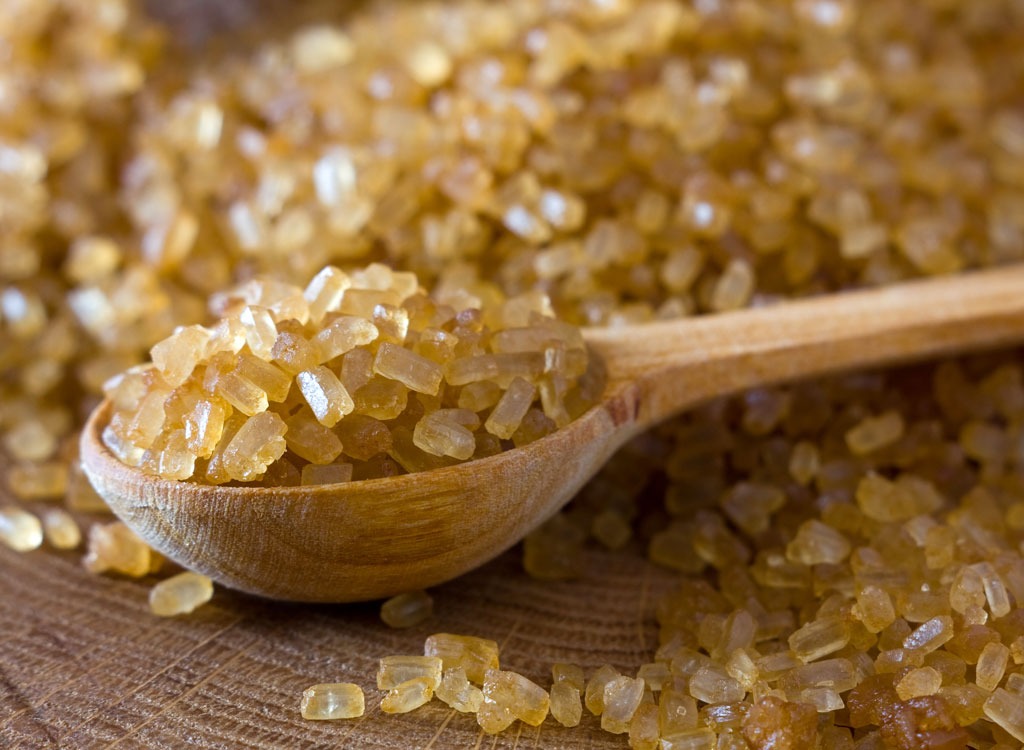
Type of sugar: Sugar extract
Glycemic Index: 65
Also known as turbinado sugar, this sugar is a dehydrated cane juice. Because it goes through less filtering, it retains more of the natural “impurities” that give it that brown, molasses-y color. However, it’s still basically just sucrose, and it has the GI to prove it.
Brown Sugar
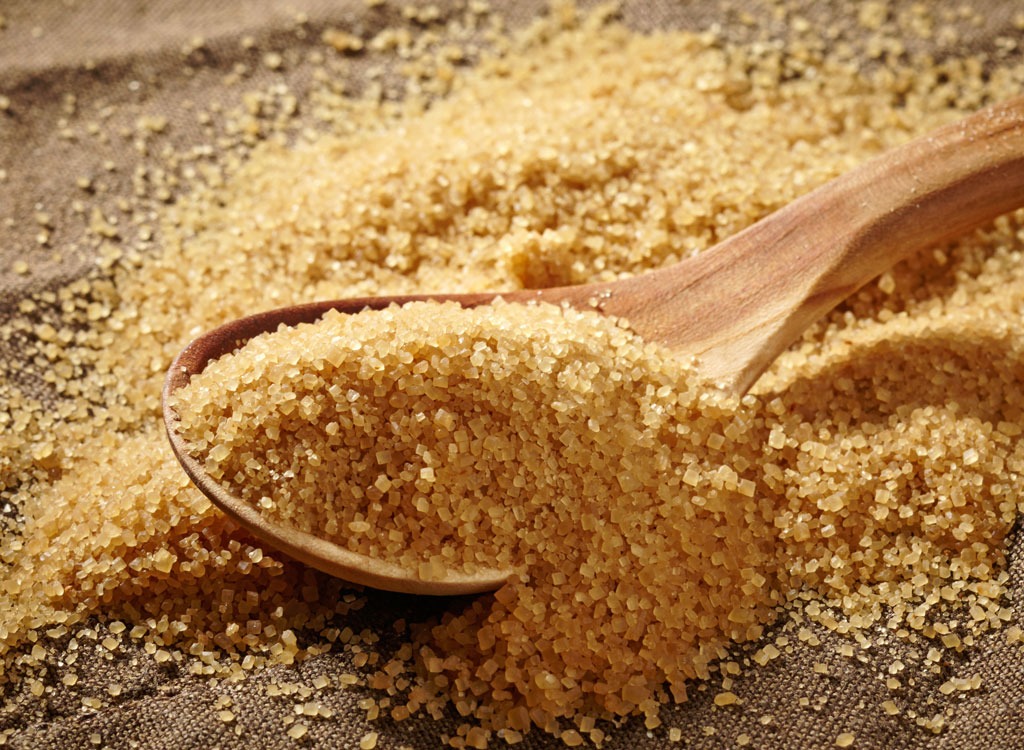
Type of sugar: Sugar extract
Glycemic Index: 65
When sugar goes through the refining process, molasses form as a by-product. To make brown sugar, these molasses are added back into it to give it back its original brown color. So this sugar almost has two forms of sugar in one! They only rank higher because molasses contain some small amounts of minerals.
Maltitol

Type of sugar: Sugar Alcohol
Glycemic Index: 35
This sugar alcohol is typically used to sweeten chocolates because it is low-calorie, important for chocolate which has high-energy healthy fats which typically up the calorie content. Maltitol is a plant-based sweetener that has only 90 percent of the sweetness of sugar. Unfortunately, studies in the European Journal of Clinical Nutrition and International Journal of Dentistry have associated maltitol consumption with stomach and abdominal pain, as well as excessive internal gas and flatulence—so much for chocolates being an aphrodisiac.
Evaporated Cane Juice OR Dried Cane Syrup
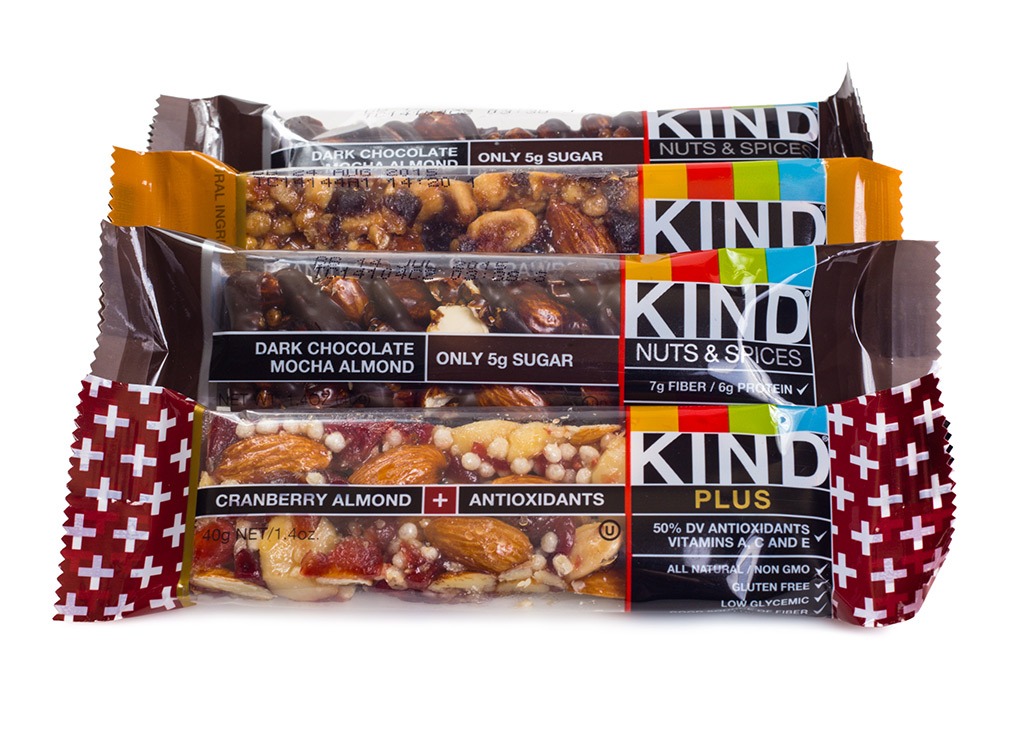
Type of sugar: Sugar Extract
Glycemic Index: 55
Just another fancy way to say sugar—which is why many granola bars, yogurts, and “health” drinks use it in their ingredients. Evaporated cane juice undergoes less processing than white, refined cane sugar, which is the only reason why it ranks a spot higher. The juice from sugar canes is filtered (which, again, separates it from “raw cane sugar”), the water is evaporated off, and the syrup is crystallized and cured, leaving the sugar granules with a tan color because of the levels of molasses still present.
Invert Sugar
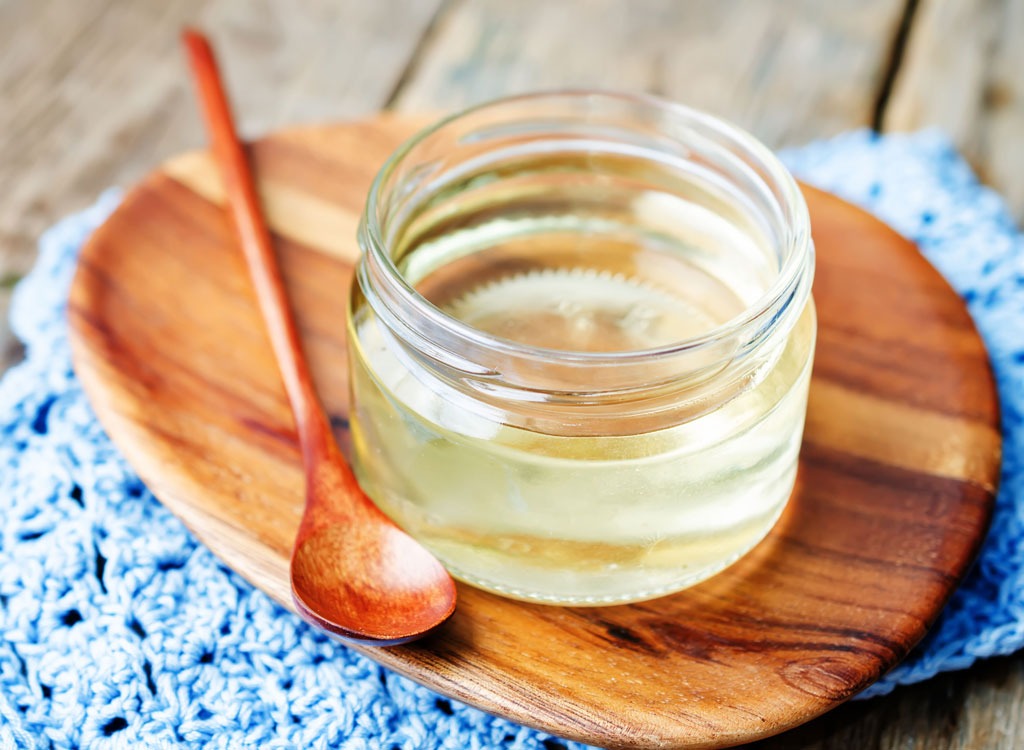
Type of sugar: Modified Sugar
Glycemic Index: 60
Invert sugar is a liquid version of sucrose, so it’s also 50-50 glucose and fructose (which makes it less bad than HFCS). It’s made in one of two ways: by subjecting sugar to acid and heat (which you can do at home using lemons), or by using an enzyme that “inverts” sucrose, causing it to split into its components. Because glucose and fructose are in free forms, invert sugar is sweeter and more soluble than sucrose. It has no nutritional value, contributes to tooth decay, and should be avoided.
Glucose Or Dextrose
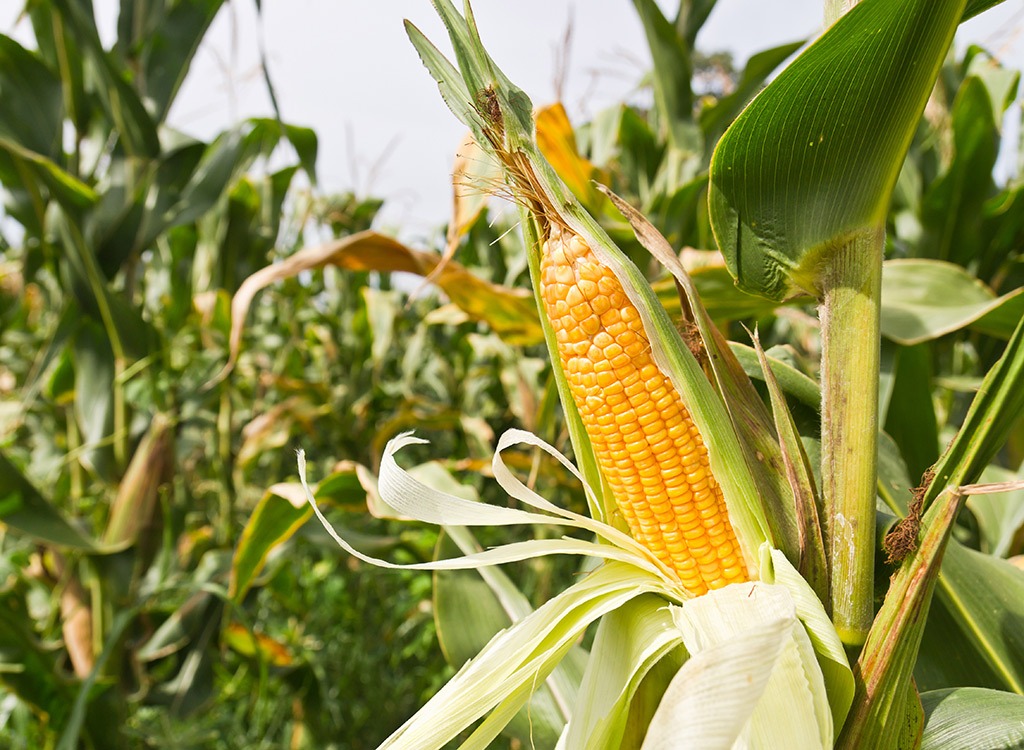
Type of sugar: Modified Sugar
Glycemic Index: 100
Glucose typically means glucose syrup, and in the U.S., it’s made from corn. So, yes, when you see this on your nutrition label, it means corn syrup. High fructose corn syrup is so called because classic corn syrups, like this one, only have 10 percent fructose. And like brown rice syrup, glucose syrup is just empty calories with no nutritive properties and its high GI can dangerously affect your insulin sensitivity and metabolism.
Brown Rice Syrup
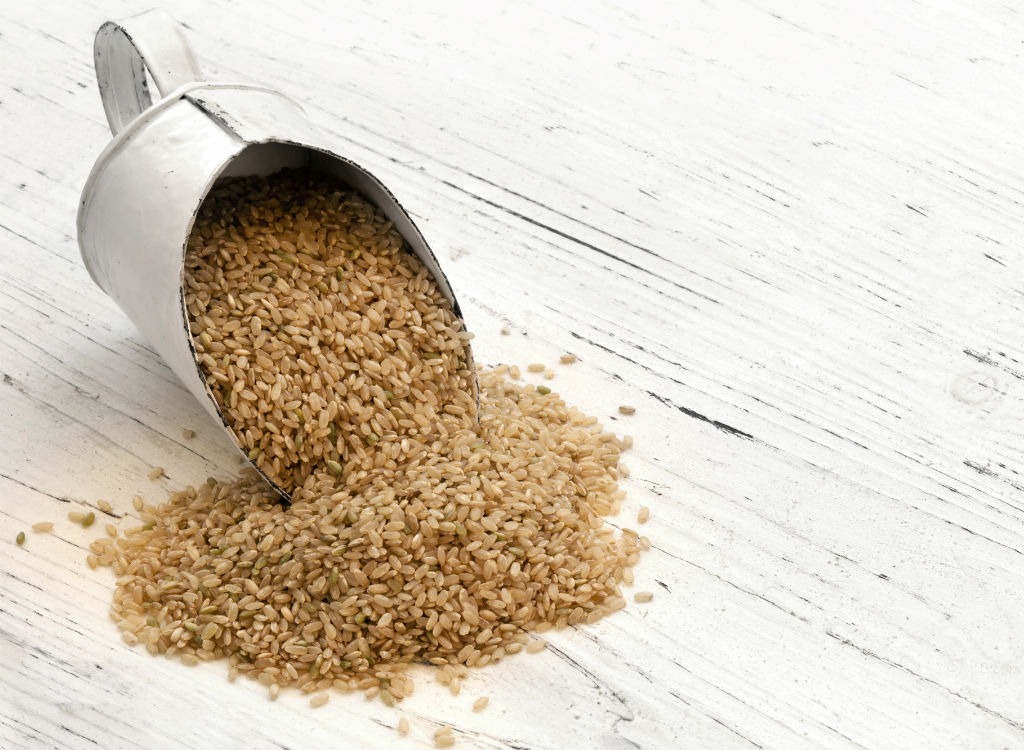
Type of sugar: Modified Sugar
Glycemic Index: >100
This sweetener is the result of the anti-fructose movement. While glucose can be metabolized by every cell in our bodies, fructose is only metabolized by the liver. When there’s too much of it, it gets turned into fat, which either sticks to the liver—causing fatty liver disease—or is shipped out, which raising blood triglyceride levels.
Brown rice syrup is made by adding enzymes to cooked rice, which break down its starches into smaller, simple sugars, and then the resulting liquid is cooked until it forms a syrup. It’s 52 percent maltotriose (3 glucose molecules), 45 percent maltose (2 glucose molecules), and 3 percent glucose—that’s a lot of glucose (and almost no nutrients). While no studies have tested the exact glycemic index of brown rice sugar, a study in the Journal Of Functional Foods found that it produced a higher glycemic response in rats compared to pure glucose, which we know has a GI of 100. So while it’s good that this sweetener doesn’t have any fructose, it does have a high GI, which is also associated with obesity.
Sucrose – Refined, Granulated Cane or Beet Sugar
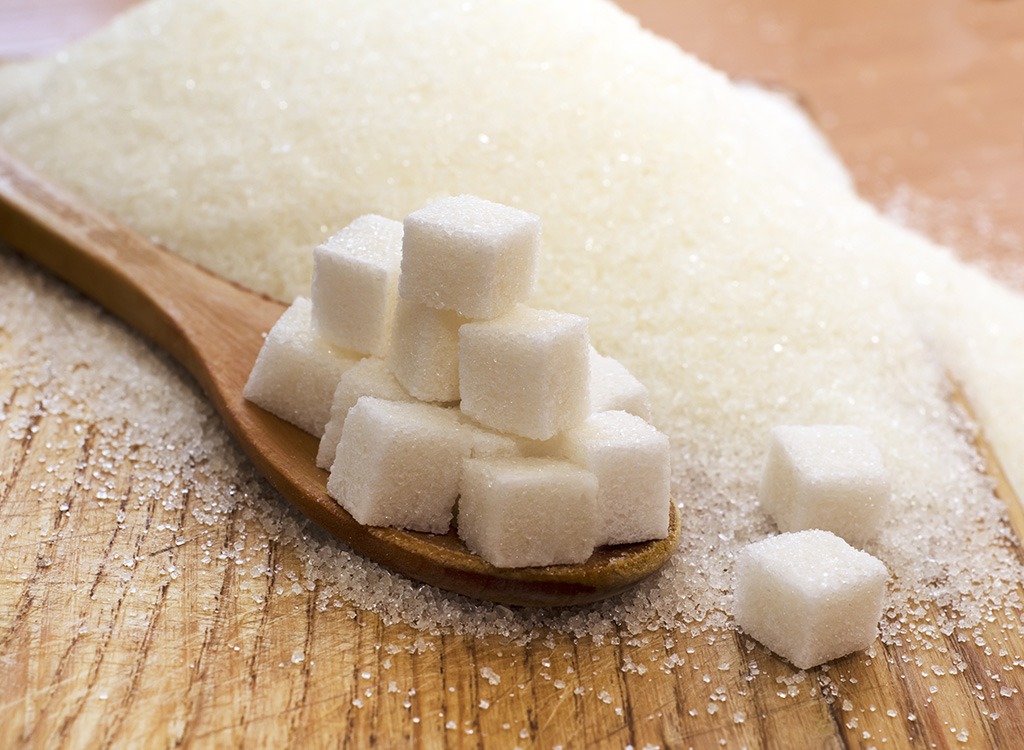
Type of sugar: Sugar Extract
Glycemic Index: 65
Sucrose is better known as table sugar, cane sugar or beet sugar, but regardless of its source, when it gets to your mouth, it’s all the same. And it turns out, if your soda is sweetened with sugar over HFCS, you might not be better off. Experts say that when sucrose is added to an acidic beverage like soda and then kept at room temperature in a warehouse before being sold, a process called inversion can take place, whereby the glucose and fructose in sucrose separate, and you end up with a product that has the same properties as a soda sweetened with HFCS.
Fruit Juice Concentrate
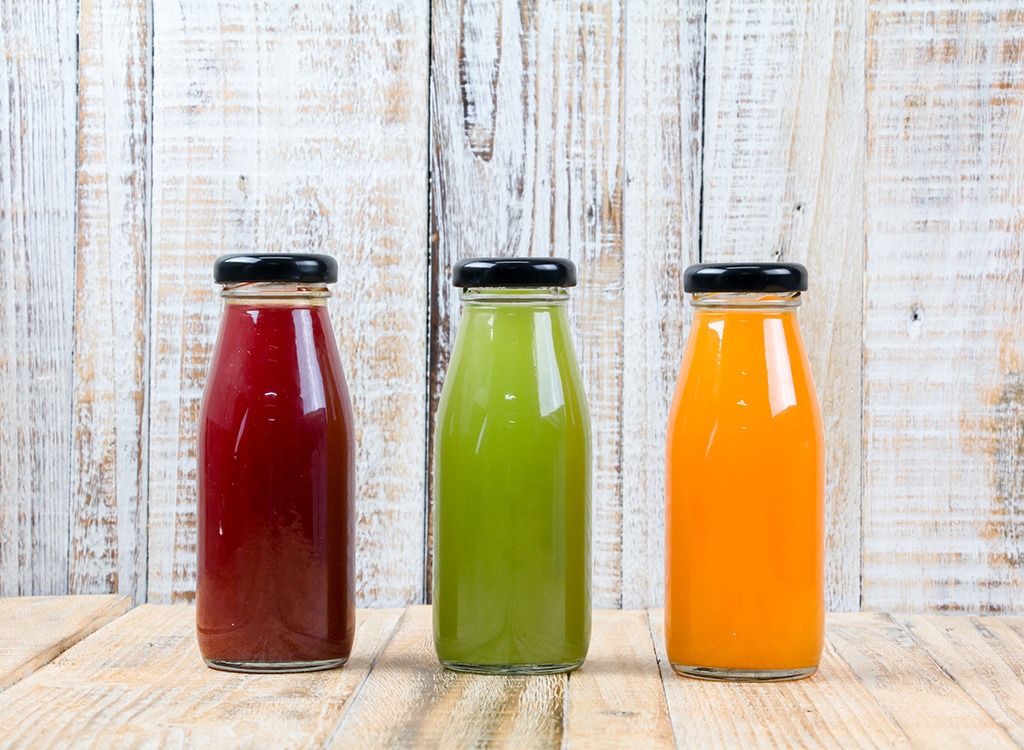
Type of sugar: Modified Sugar
Glycemic Index: 50-80
Many manufacturers have started using juice concentrates such as apple, grape and pineapple to sweeten anything from bread to teas. These usually contain 70 percent soluble solids composed of the various sugars found naturally in the original fruit–which means they can be just as high in fructose, if not higher, than HFCS. They only rank higher because they’re more “natural” than other sugars and may contain trace amounts of vitamins and minerals.
Agave Syrup

Type of sugar: Modified Sugar
Glycemic Index: 15
Agave is considered a modified sugar because the sugars aren’t available through a simple extraction. Agave juice is extracted from the core of the plant, it’s filtered, and then heated to break the longer chains (polysaccharides) of sugars into simple sugars. And these sugars are mostly fructose. Like, 90 percent fructose, which can be worse than most high fructose corn syrups. And while some argue agave is still a healthier sweetener because it’s sweeter than sugar and doesn’t spike your blood sugar, studies suggest we really should be worried about the high fructose content, which is associated with health issues like liver and kidney disease, high blood pressure, and even signs of premature aging.
High-Fructose Corn Syrup-90
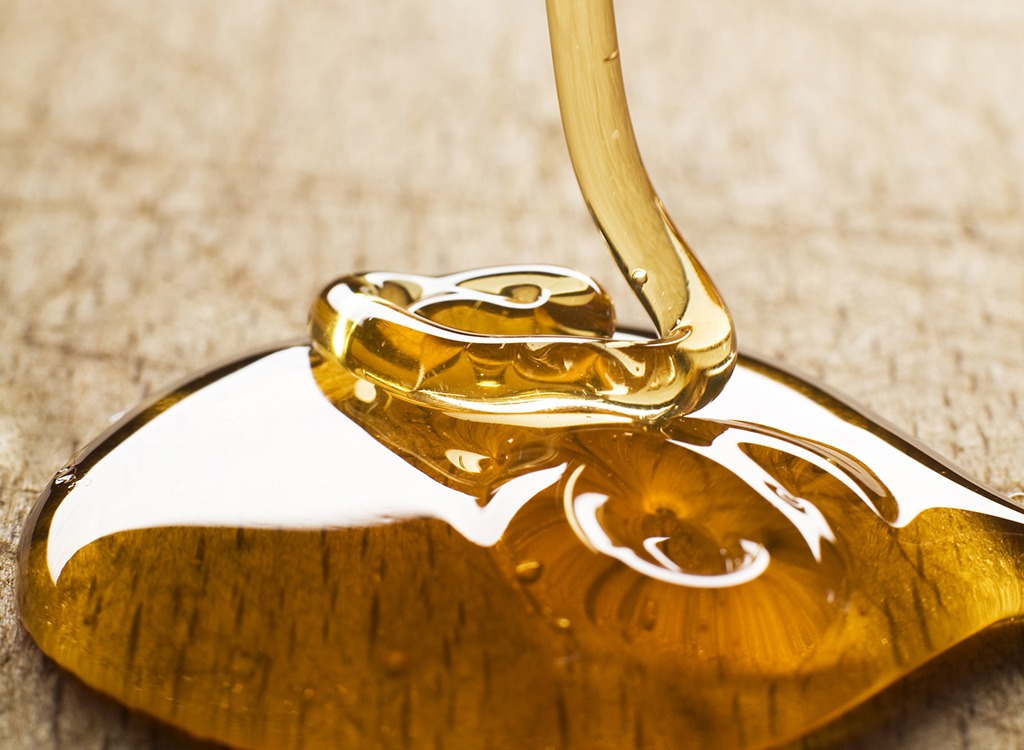
Type of sugar: Modified Sugar
Glycemic Index: HFCS-90: 31; HFCS-55: 58; HFCS-42: 68
High fructose corn syrup is a sweetener made from the carbs in corn. It may surprise you, but one of the most common forms, HFCS-55, actually has a similar chemical makeup to sugar—the 55 representing the percentage of fructose, which in sucrose is only 50; however, many manufacturers use HFCS-90, which has dangerous levels of fructose. Because of the higher concentration of fructose, HFCS is sweeter than sugar. But just because you use less of it to get the right sweetness doesn’t mean you should use it. The scientific community has been flooded with studies that connect fructose-sweetened—not glucose-sweetened—beverages to an increase visceral adiposity and lipids and a decrease in insulin sensitivity in overweight/obese humans.
And now for the #1 Worst Added Sweetener…A Three-Way Tie!
Acesulfame K
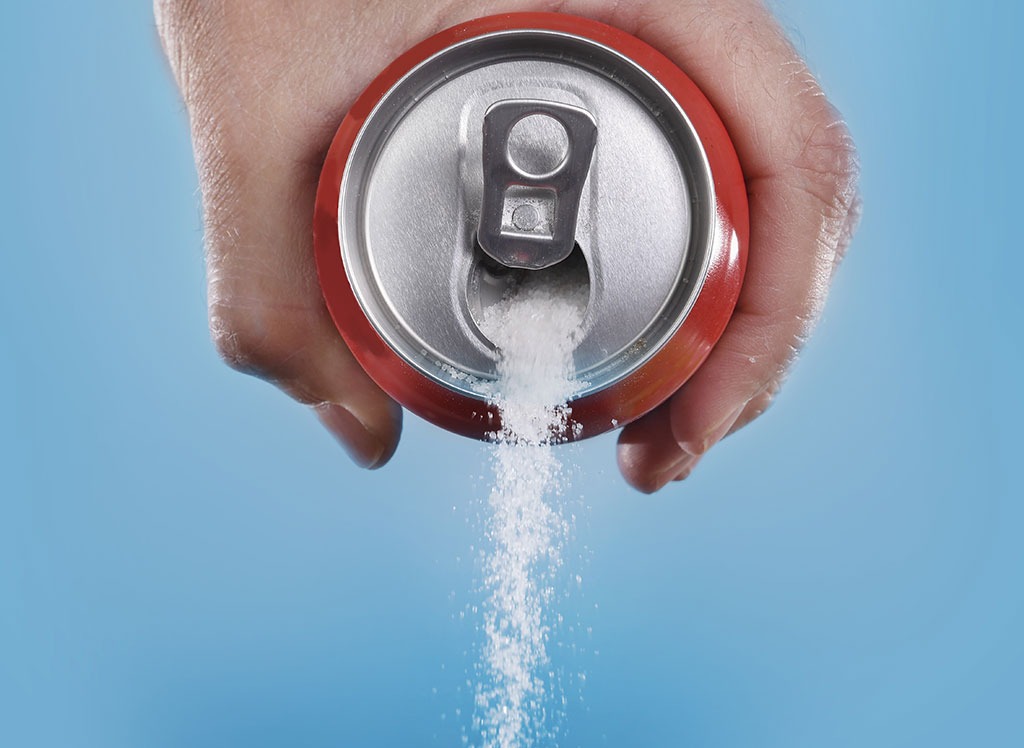
Type of sugar: Artificial, High-Intensity Sweetener
Glycemic Index: 0
A synthetic sweetener, acesulfame K has been linked to cancer in rodent studies. Because it’s not too sweet and has a bitter taste, it’s almost always combined with sucralose when manufacturers use it as a sweetener. This way, they each cancel out each other’s bitterness. Studies have found that artificial sweeteners like this one can cause glucose intolerance, which ultimately results in confused hormones and weight gain.
Aspartame
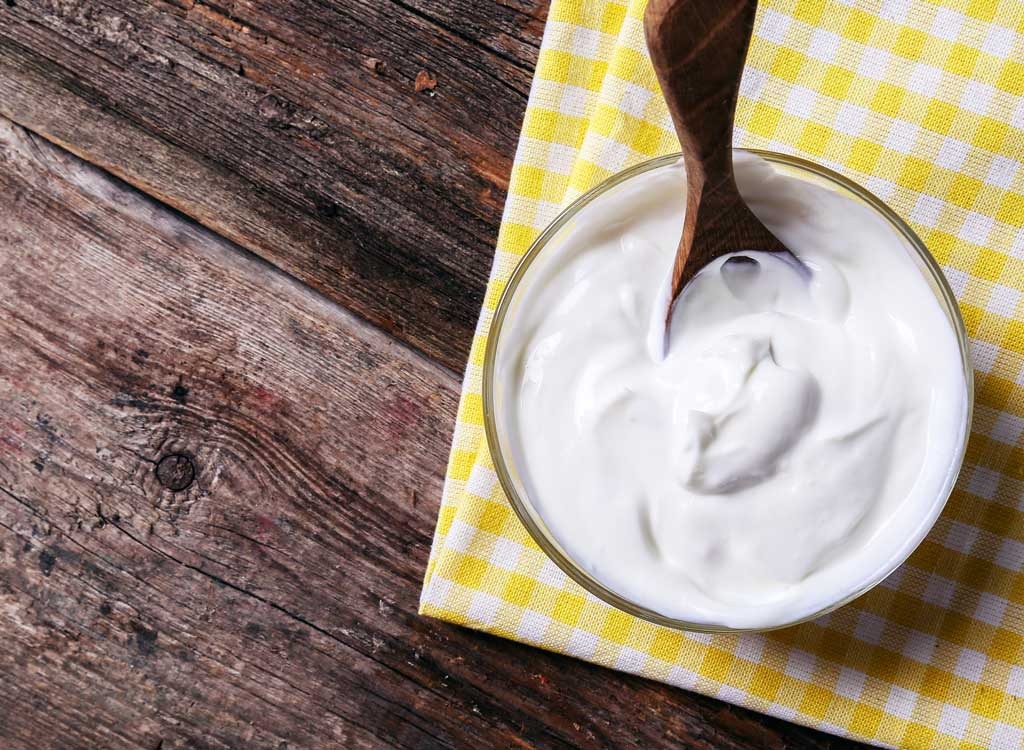
Type of sugar: Artificial, High-Intensity Sweetener
Glycemic Index: 0
This sweetener was typically used in many soft drinks, desserts, and yogurts to lower their calorie and sugar count until much public outcry over its possible dangers. People who have phenylketonuria (PKU), a rare genetic disorder, have a difficult time metabolizing phenylalanine, an amino acid component of aspartame. If you don’t have PKU, you won’t suffer from the same negative effects—that include brain damage and seizures—however, the Mayo Clinic advises that people avoid consuming this sweetener in high doses. This is because the sweetener can flood your brain with phenylalanine, causing feelings of anxiety and jitteriness.
Saccharin
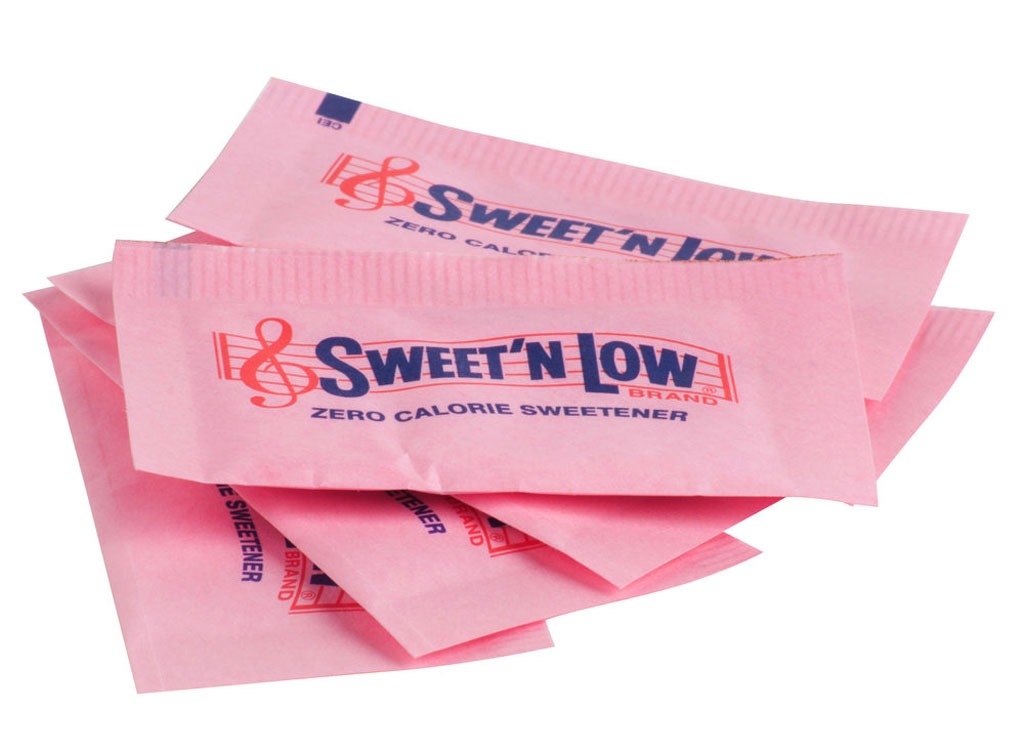
Type of sugar: Artificial, High-Intensity Sweetener
Glycemic Index: 0
Saccharin is a synthetic chemical that is structurally unlike any form of sugar our bodies can metabolize; however, it still activates our taste buds, and does so at levels 200-700 times the amount sucrose does. The U.S. National Cancer Institute noted that one of its own studies had found “some evidence of an increased risk of bladder cancer” in heavy saccharin users, “particularly for those who heavily ingested the sweetener as a tabletop sweetener or through diet sodas.” And “heavy” only meant two or more 8-ounce servings of diet drinks daily, which we’ve known people to consume more of.
Ultimately the research on saccharin is all over the map, but a 2015 review of all outstanding studies on saccharin in Advances in Food Sciences concluded that with the degree of inconsistencies in results, people should still be careful about the consumption of this sweetener in terms of toxicity. If that’s not reason enough for you to avoid it, maybe a study published in Nature that found saccharin consumption in both mice and humans enhances the risk of glucose intolerance by altering our gut microbiome. Researchers found an increase in bad gut bacteria that have previously been associated with type 2 diabetes.
